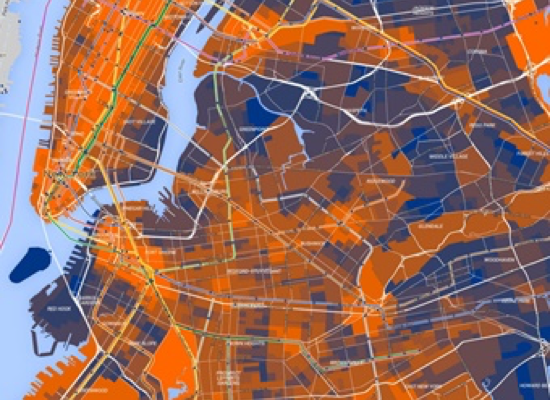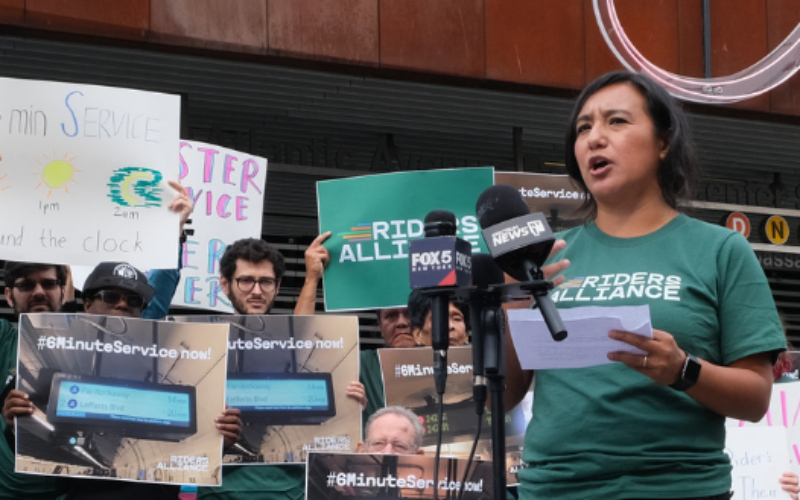
 To celebrate the launch of AllTransit, the TransitCenter staff held an informal competition to determine who grew up in the most transit-rich and transit-poor parts of the country. Each of us entered his or her childhood address to compare our hometowns’ AllTransit Performance Scores. These scores combine schedule and location data from more than 800 transit agencies with data from the U.S. Census Bureau data to measure transit connectivity, access, and frequency. The score accounts for the number of nearby transit trips per week, the number of transit routes within a half mile, the number of jobs accessible in a 30-minute transit trip, and the percentage of local commuters who use transit.
To celebrate the launch of AllTransit, the TransitCenter staff held an informal competition to determine who grew up in the most transit-rich and transit-poor parts of the country. Each of us entered his or her childhood address to compare our hometowns’ AllTransit Performance Scores. These scores combine schedule and location data from more than 800 transit agencies with data from the U.S. Census Bureau data to measure transit connectivity, access, and frequency. The score accounts for the number of nearby transit trips per week, the number of transit routes within a half mile, the number of jobs accessible in a 30-minute transit trip, and the percentage of local commuters who use transit.
For our competition, the winner—or loser, as the case may be—was the TransitCenter employee with the lowest score. The prize: bragging rights, a week’s supply of yogurt, and the sympathy of coworkers. Browse the map below to see how TransitCenter staff fared—the darker the pin, the better that employee’s Performance Score.
There were several surprises, namely that Joelle, who grew up in a part of Juneau, Alaska, with the bleak Performance Score score of 1.9, did not take last place. Her isolated hometown managed to tie one upstate New York village, and beat out Pomona, New York, which is just 30 miles from the country’s busiest transit hub in Times Square.
The gaps between scores were notable as well, indicating there’s not a lot of middle ground in terms of transit accessibility in the U.S., at least using our staff as an (admittedly unscientific) sample.
Here are the scores, from highest to lowest, with descriptions of each place from the TransitCenter team member who was fortunate or unfortunate enough to grow up there:
Jake Anbinder – Arlington, Virginia: 9.5
“Growing up in Arlington I was spoiled by good transit and good street design. My house was ten minutes from the Metro and even closer to frequent buses, not to mention grocery stores, restaurants, and parks. The only drawback was the crowding on the Orange Line in the mornings going to high school, which was worse than anything I’ve encountered in New York—not for nothing that they call it the Orange Crush.”
Julia Ehrman – Newton, Massachusetts: 8.9
“Newton is a pleasant city of thirteen villages just seven miles outside of Boston. The first commuter train connecting Newton to Boston was built in the mid 1800s. Newton has no shortage of smoked fish and a remarkable supply of Concord grapes growing in unexpected places.”
Steven Higashide – Iselin, New Jersey: 8.7
“Iselin, where I went to elementary and middle school, is a classic first-ring suburb, an Amtrak hub, and a nationally significant center of Indian-American immigration. Neighboring Colonia, where I moved before high school, is less interesting, less walkable, and way less transit-friendly (2.0).”
David Bragdon – Portland, Oregon (97202): 8.4
“From seventh grade through high school I lived in Portland, which has subsequently emerged as a good city for transit but at the time of my high school years its transit was not comprehensive. I started advocating for better transit when I wrote an article about the need for it in the daily newspaper.”
Zak Accuardi – Portland, Oregon (97212): 8.2
“Many neighborhoods in Portland live up to the city’s reputation as a livable, walkable place, but the city as a whole still a long way to go. My neighborhood in Northeast Portland was relatively dense single-family residential, so growing up I got to walk and bike most places I needed to go. The car culture was still strong though—most of my peers in high school (myself included) still dreamt of the freedom afforded by car ownership.”
Tabitha Decker – Milwaukee, Wisconsin: 7.9
“Milwaukee is Wisconsin’s largest city. Its many parks and public spaces are part of the legacy of early twentieth century sewer socialism. In the second half of the century, highways, parking craters, and car-dominated streets became ubiquitous. Today, Milwaukee is a contender for the country’s most segregated city and a place where transit is often stigmatized as a mode of last resort. This helps explain why the 7.9 score surprised me. While I don’t drive, I didn’t use transit in Milwaukee when I was growing up. I’ll test out transit access on my next visit.”
Jon Orcutt – Lexington, Massachusetts: 4.8
“Lexington is a ‘first ring’ Boston suburb whose train service closed down in the 1960s. A slow bus and slower transfer to a second bus in Arlington would get you the nine miles to Harvard Square, so I honed my cycling-in-traffic skills on that route instead.”
Stephanie Lotshaw – Niskayuna, New York: 3.5
“Niskayuna is a suburban town in the Capitol Region (a.k.a. Albany, NY). (I can’t think of anything else to say about it except what it isn’t—no downtown, no main street, doesn’t have its own transit agency.) Fun fact (that I learned from Wikipedia, trying to figure out what else to say about the place): one of the co-founders of Airbnb grew up there as well!”
Joelle Ballam – Juneau, Alaska: 1.9
“Where the number of annual inches of rainfall (62) exceeds the number of miles of road in the city (45), and where humans only outnumber bald eagles by approximately 2,600. With no roads in or out, Juneau is the nation’s most isolated state capital.”
Shin-pei Tsay – Jamesville, New York: 1.9
“Once a hamlet in the town of Dewitt within the historically thriving region around Syracuse, Jamesville was swept up along with the rest of the region by the ‘innovations’ of the 1970s and ‘80s—single-family housing tracts and major highway projects. Those decisions have since erased evidence of once-bustling town centers and people-friendly main streets, and though a wonderful community persists, the region has been slowly been losing population for nearly 40 years.”
Jennifer Elam – Grand Ronde, Oregon: 0.7
“There’s not a lot to say. It was/is an incredibly small, rural town in Oregon. The primary industry and source of jobs was the timber industry, which basically when bust in the late 1980s/early 1990s because of the fight over the spotted owl. The main source of jobs now is the Spirit Mountain Casino, which was built right after I moved away at 15. It had/has high unemployment, high drug use, and high teen pregnancy rates. Most kids who graduate from the high school (located in neighboring Willamina) don’t go on to college. It sucked and I’m glad I don’t live there anymore.”
Kirk Hovenkotter – Sammamish, Washington: 0.0
“Sammamish, incorporated in 1999, narrowly avoided being named Heaven and is Microsoft’s premier bedroom community™. Its urban form of McMansions, four car garages, and culs-de-sac created the 25 minute traffic jam to get into high school everyday, initiating my descent into urban planning.”
Melissa Plaut – Pomona, New York: 0.0
“I was born in New York City but my parents moved us from the Bronx to the suburbs when I was still small. I spent my formative years in a town called Pomona, a bedroom community in Rockland County that allowed my parents to commute—by car, of course—back into the city every day. Despite being less than 40 miles from the city, my childhood home delivers a score that might explain some of my teen angst as well as my subsequent interest in improving transit for all the suburban teenagers who continue to suffer in silence.”
Among our most notable findings is that a place in Downstate New York has one of the two lowest scores among TransitCenter hometowns. The other, Sammamish, is just 15 miles from downtown Seattle. Kirk and Melissa earn bragging rights to what were arguably the worst childhoods ever, at least as far as transit is concerned. Proof that just as good transit can happen anywhere, inner-ring suburbs can also be transit death traps.
Today, the TransitCenter staff enjoy far superior Performance Scores at their respective homes in Brooklyn. (That’s not a joke—we actually all live in Brooklyn.)
Enter your own address into AllTransit and see your hometown’s Performance Score.
 On the Brink: Will WMATA’s Progress Be Erased by 2024?
On the Brink: Will WMATA’s Progress Be Erased by 2024?
The experience of being a WMATA rider has substantially improved over the last 18 months, thanks to changes the agency has made like adding off-peak service and simplifying fares. Things are about to get even better with the launch of all-door boarding later this fall, overnight bus service on some lines starting in December, and an ambitious plan to redesign the Metrobus network. But all of this could go away by July 1, 2024.
Read More Built to Win: Riders Alliance Campaign Secures Funding for More Frequent Subway Service
Built to Win: Riders Alliance Campaign Secures Funding for More Frequent Subway Service
Thanks to Riders' Alliance successful #6MinuteService campaign, New York City subway riders will enjoy more frequent service on nights and weekends, starting this summer. In this post, we chronicle the group's winning strategies and tactics.
Read More